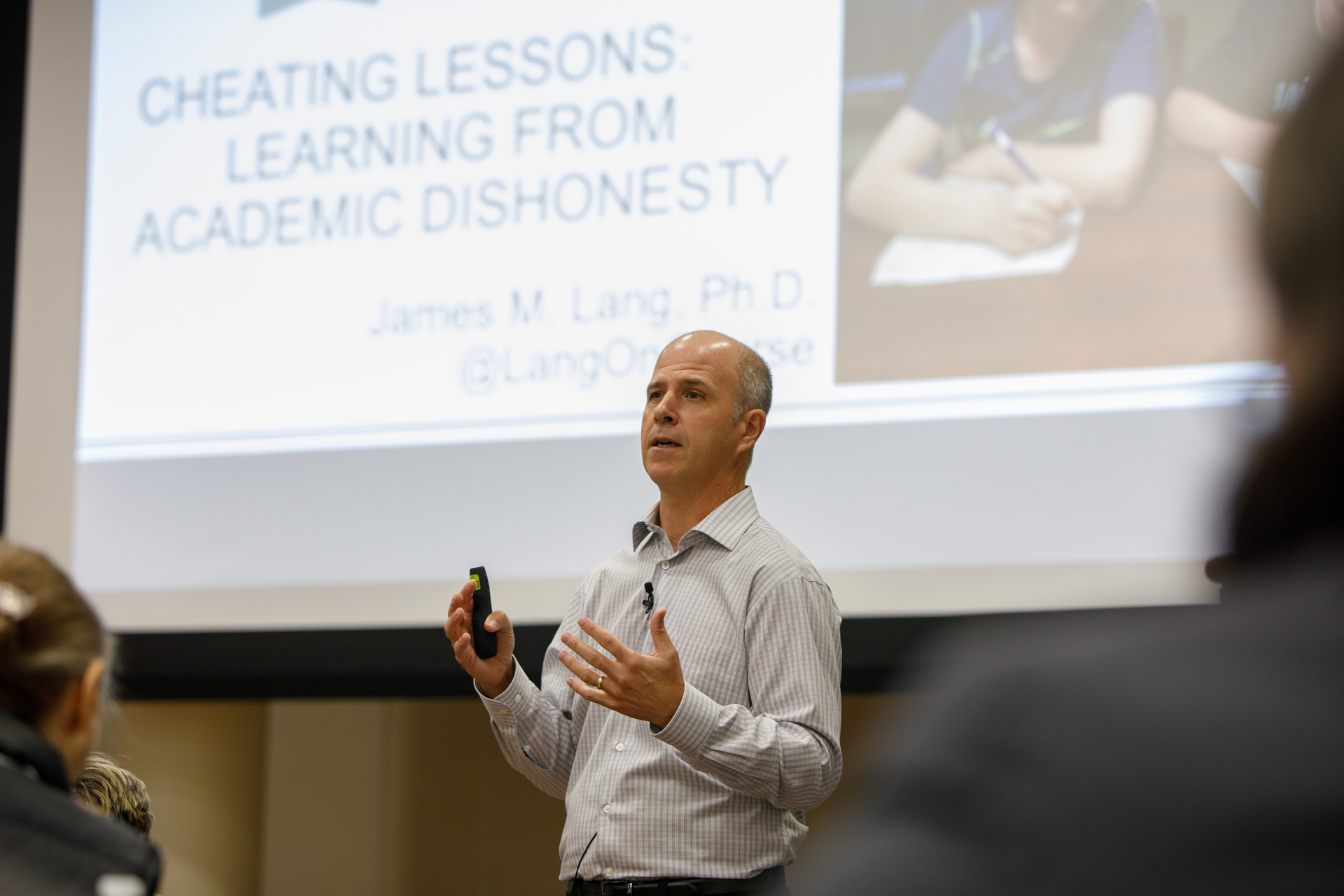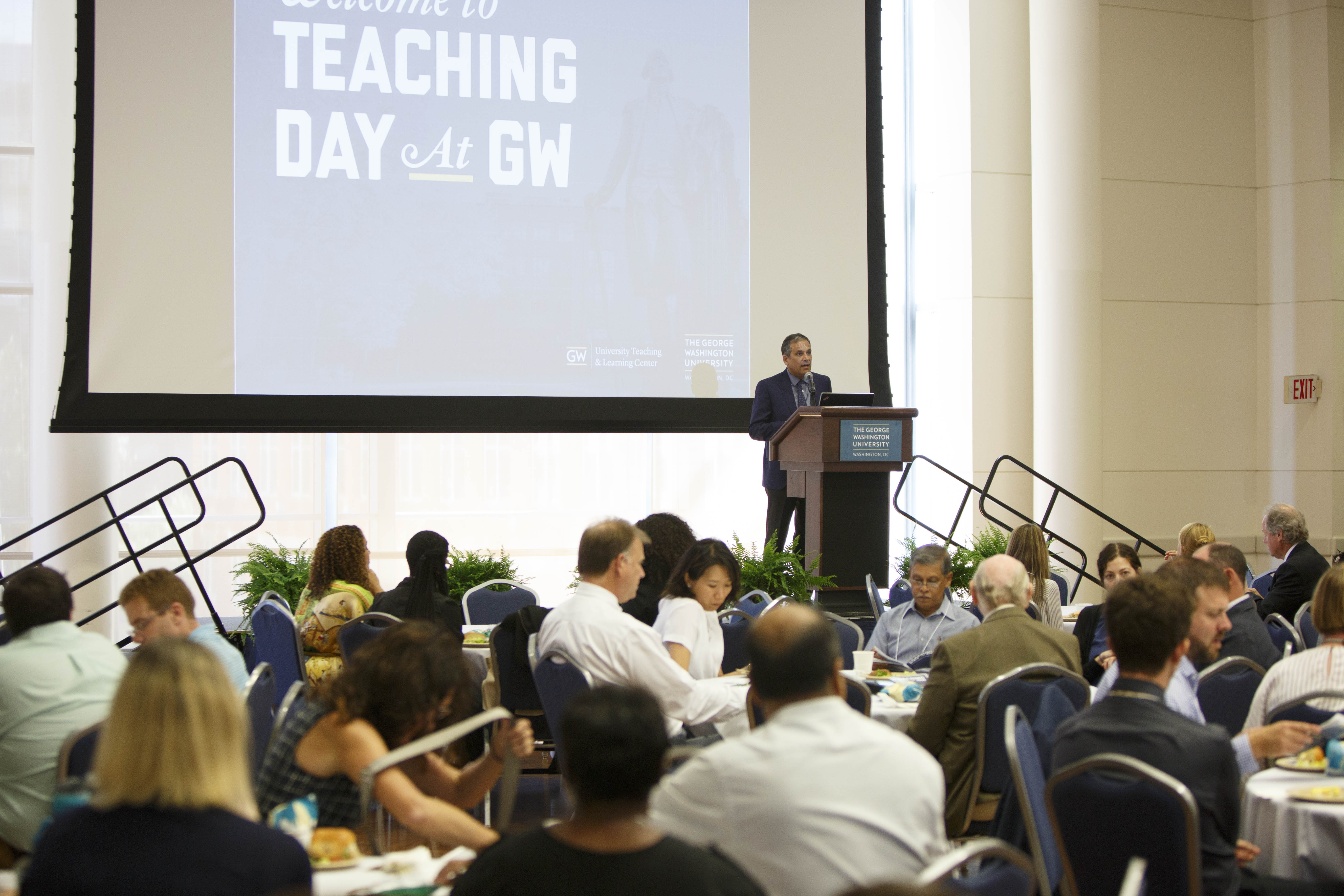By Ruth Steinhardt
Academic dishonesty is a bugbear for teachers, especially as online sources of course information become more comprehensive and accessible. But James Lang believes the propensity of students to cheat can actually provide teachers an opportunity to figure out more effective learning environments.
Dr. Lang, an English professor and director of the D’Amour Center for Teaching Excellence at Assumption College in Worcester, Mass., is the author of “Cheating Lessons: Learning from Academic Dishonesty.” He was the keynote speaker at the George Washington University’s eighth annual Teaching Day, presented Thursday by the University Teaching and Learning Center.
“Teaching and Learning Day is about exploring new approaches to teaching,” Geneva Henry, dean of libraries and academic innovation, said. “Becoming a more effective instructor requires a mindset of innovation…and even with that, you cannot be successful in doing what you want to do if you don’t have an infrastructure behind you. We are here to break down any barriers you might be running into.”
Online databases of essays and assignments are hard to screen out, Dr. Lang said. As technology gets sleeker, more discreet and more difficult to ban from the classroom—watches, pens and glasses are among the devices students can use to access the Internet—professors run the risk of getting involved in an unwinnable “arms race,” he said. “To me, that’s not very productive.”
“We can learn from academic dishonesty how to be more effective educators, instead of just thinking about this as a technical problem to be prevented or a violation we have to respond to,” Dr. Lang said.
The research indicates several factors that play into whether students are likely to cheat, Dr. Lang said. Certain disciplines are more vulnerable to academic dishonesty: Business is historically the field with the most cheating, while performance-based disciplines like music have the least. Cheating happens more in larger classes than in smaller ones, and more in first-year-level classes than in senior ones.
It also happens more where there is confusion about what constitutes academic dishonesty, Dr. Lang said—and confusion is widespread. In one study, professors reviewed a spectrum of paragraphs ranging from legitimate paraphrase to unacceptable plagiarism and were asked to mark where the line lay. There was almost no consensus.
“We can help students understand what it means to do work with integrity in this context, instead of saying ‘Don’t cheat, don’t cheat, don’t cheat,” Dr. Lang said.
Finally, Dr. Lang said, certain types of learning environments encourage dishonesty. Students who are motivated by external validation, like parents who care deeply about their grades, are more likely to cheat. So are students who are oriented toward performance instead of mastery of a subject—by getting a higher grade than others in a class instead of by being able to use the skills they’re trying to learn. Classes with infrequent, high-stakes evaluations are more likely to see cheating than classes with many low-stakes evaluations like quizzes and short papers. And students with low feelings of self-efficacy, who doubt their own capability to grasp a subject or complete a task, are more likely to cheat.
“That’s different from low self-esteem,” Dr. Lang said. Teachers have an influence on this as well: Telling a class that only one or two students will succeed at a task, for instance, causes low self-efficacy across the class.
But there are ways to modify a learning environment that can counter all these motivations for cheating, Dr. Lang said. And not only that, but these modifications “can also boost learning even for students who would never cheat.”
When students discuss their most meaningful college work, Dr. Lang said, they mention three general themes: opportunities for agency, engagement with instructors, peers and materials, and connections to their passions, previous experiences and future aspirations. Designing courses that give students that agency, engagement and connection can help professors avoid academic dishonesty.
As an example, Dr. Lang named a colleague whose huge lecture classes involved thousands of students. Rather than provide traditional assessments, the professor established a “menu” of projects and assignments from which students can choose opportunities to learn. The menu adds up to 1,500 points, and students need only 1,000 points to earn an A. They therefore have agency to choose what interests them.
Motivation can also come from “connection to authentic problems,” Dr. Lang said. A different colleague had her psychology students do projects on parts of the brain, then present these to local elementary school students as part of “Brain Awareness Week.” The connection to the community and the presence of vulnerable populations made it difficult for students to cheat.
“What I would encourage you to take away from this most of all…is the next time you have a student cheating, you’re going to be annoyed and frustrated,” Dr. Lang said. “But also step back and say ‘What happened here, and is there anything I can do differently for the next student that will make a difference?’”
In addition to his keynote, Dr. Lang offered a morning master class for faculty and an afternoon session for graduate students on "Small Teaching: From Minor Changes to Major Learning." Morning concurrent sessions and an afternoon poster session focused on the pedagogical research of almost 60 GW faculty members. Subjects included student assessment, curriculum design, and community-engaged scholarship.
The UTLC provides teaching support for faculty with special emphasis on course design, course delivery and experimentation with teaching. It is part of the division of Libraries and Academic Innovation, which integrates teaching, learning and research across the university.



